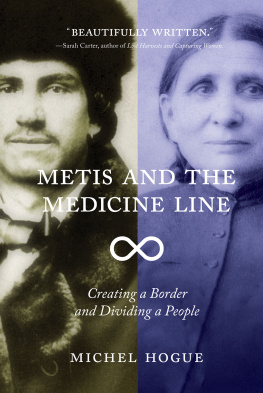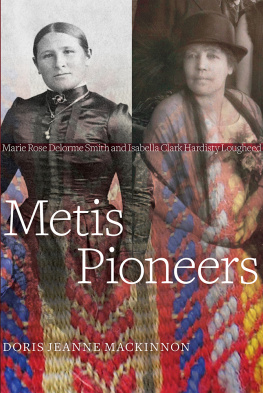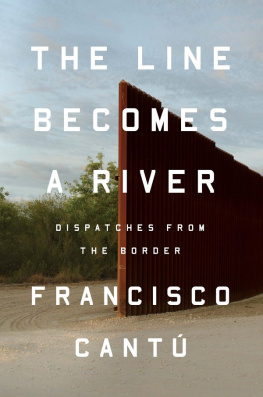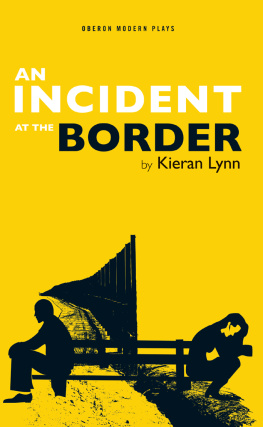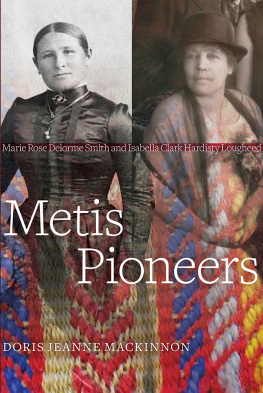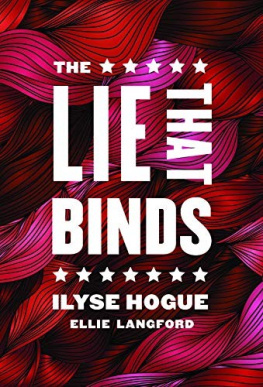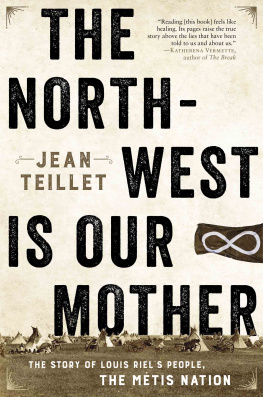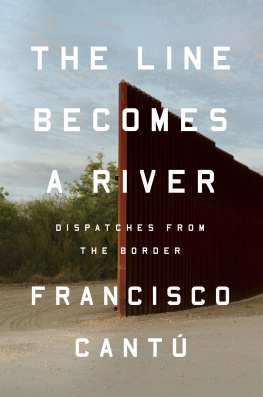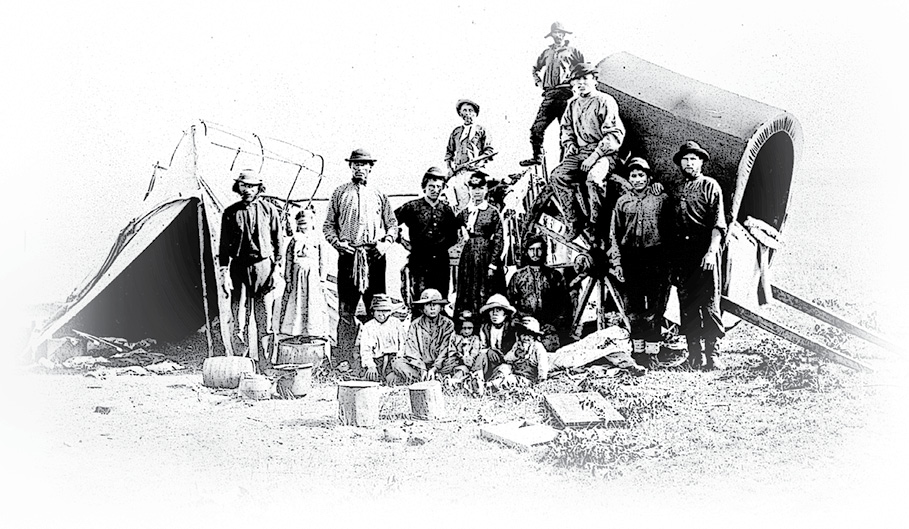Me t is
and the Medicine Line
Creating a Borde r and Dividing a People
* * *
Michel Hogue
Metis and the Medicine Line: Creating a Border and Dividing a People by Michel Hogue. Copyright 2015 by the University of North Carolina Press.
This edition has been published by arrangement with the University of North Carolina Press, Chapel Hill, North Carolina 27514, USA www.uncpress.unc.edu
Printed and bound in Canada at Marquis. The text of this book is printed on 100% post-consumer recycled paper with earth-friendly vegetable-based inks.
Cover design: Duncan Campbell
Text design: Richard Hendel
cover images: left : Mixed blood (Indian and French) fur trader, detail, courtesy Minnesota Historical Society. Used with permission; right : Angelique Bottineau Ouellette, wif e of Antoine Ouellette [n o date] , detail, copied from photograph loaned by George J . Wells , Vancouver, B.C. (944-234). Montana Historical Society Research Center Photograph Archives, Helena. Used with permission.
Library and Archives Canada Cataloguing in Publication
Hogue, Michel, 1974-, author Metis and the medicine line : creating a border and dividing a people / Michel Hogue.
Includes bibliographical references and index.
Issued in print and electronic formats.
Co-published by: The University of North Carolina Press.
ISBN 978-0-88977-380-6 (paperback).--ISBN 978-0-88977-381-3 (html).--
ISBN 978-0-88977-382-0 (pdf)
1. Mtis--Canada, Western--History. 2. Mtis--Great Plains--History.
3. Mtis--Government relations. 4. Mtis--Ethnic identity. 5. Northern
boundary of the United States--Ethnic relations. 6. Northern boundary of
the United States--History--19th century. 7. Red River Settlement--History.
8. Montana--Ethnic relations. 9. Borderlands--Canada--History.
10. Borderlands--United States--History. I. Title.
E99.M47H64 2015 05.897'071 C2015-901678-9 C2015-901679-7

University of Regina Press, University of Regina
Regina, Saskatchewan, Canada, S4S 0A2
tel: (306) 585-4758 fax: (306) 585-4699 web: www.uofrpress.ca
Portions of this work have appeared previously, in somewhat different form, as Between Race and Nation: The Creation of a Mtis Borderland on the Northern Plains, in Bridging National Borders in North America , ed. Benjamin H. Johnson and Andrew R. Graybill (Durham: Duke University Press, 2010), and Montana Metis and the Boundaries of Belonging, in Contours o f a People: Metis Family, Mobility, and History , ed. Nicole St-Onge, Carolyn Podruchny, and Brenda Macdougall (Norman: University of Oklahoma Press, 2013), and are reprinted here with permission.
The University of Regina Press acknowledges the generous financial support for our ongoing publishing program from:
the Grants to Publishers program, made possible through funding provided to Creative Saskatchewan by the Government of Saskatchewan through the Ministry of Parks, Culture, and Sport
the Government of Canada through the Canada Book Fund
the Canada Council for the Arts
This publication was made possible thanks to:
Culture on the Go funding provided to Creative Saskatchewan by the Ministry of Parks, Culture, and Sport
a grant from the Federation for the Humanities and Social Sciences, through the Awards to Scholarly Publications Program, using funds provided by the Social Sciences and Humanities Research Council of Canada



Acknowledgements
In the many years it took to research, write, and revise this book, I have accumulated many debts. First, I owe Susan Johnson more than I can convey here. But I am especially grateful for her hands-on efforts to reconfigure early drafts of this work into something rather more graceful and compelling. Likewise, Bill Cronon and Ned Blackhawk played critical roles in shaping this book, and I am very privileged to have had the opportunity to work closely with both. I am grateful for David McDonalds willingness to help see this project through its early stages and for Sarah Carters incisive comments on those early drafts. Guidance in research and professional matters has long been provided by Sarah and by Betsy Jameson. They, along with the late Nora Faires, started me down this path many years ago. Thank you!
The generous financial support from the following organizations helped underwrite aspects of this research: the Canadian Social Sciences and Humanities Research Council (SSHRC ), the Canada-U.S. Fulbright Program, Carleton Universitys Faculty of Arts and Social Sciences, the Graduate Student Collective (University of Wisconsin), the University of Wisconsin History Department, the Canadian Studies Association, and the Committee on Institutional Cooperations American Indian Studies Program. I also thank Dr. Robin Jarvis Brownlie (University of Manitoba) and Father Andr Dubois (Archives Deschtelets) who wrote letters of support for my funding applications as a graduate student and who did so without ever having met me.
This book would not have been possible without assistance from staff at libraries and archives from across Canada and the United States. I thank, in particular, the staff at the Montana Historical Society for the many ways they have supported this work. Brian Shovers, Becca Kohl, Jeff Malcomson, and Zoe Ann Stoltz went out of their way to help me locate materials, as did the rest of the staff at the Historical Societys research center. Thanks also to Kirby Lambert for the invitations to present earlier iterations of this work at the societys annual history conference. I am very grateful for the assistance provided by Marene Baker at the Denver Federal Records Center, Mark Thiel at the Marquette University Archives, Jacinthe Duval at the Saint-Boniface Historical Society, Carmen Harry at the Royal Canadian Mounted Police Museum, Carla Frankow at the Treaties and Historical Research Centre, Ken Robison at the Overholser Research Center, and Nancy Mulhern at the Wisconsin Historical Society Library. I am also indebted to the staff at the Newberry Library, Saskatchewan Archives Board (Regina and Saskatoon), the Provincial Archives of Manitoba, the Merrill Burlingame Special Collections at Montana State University, Glenbow Archives, University of Vermont Special Collections, Minnesota Historical Society, North Dakota Historical Society, the National Archives and Records Administration (Washington, D.C.), and Library and Archives Canada. Finally, I could not have completed this work without the efficient help provided by the staff at the Inter-Library Loans Department at Carleton Universitys MacOdrum Library and those at the University of Wisconsin-Madison libraries.

